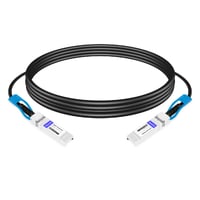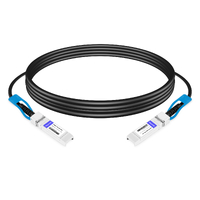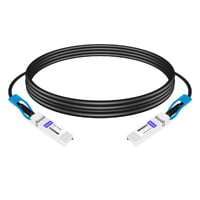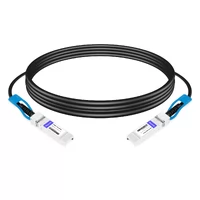In short-range communication applications, the 25G SFP28 Twinax Direct Attach Copper (DAC) cables are helpful in data center connectivity. Such cables were created to meet the needs of modern networks that require high performance and bandwidth. They use a low-cost method with low latency to send data from servers, switches, and other network devices within a short range. Standard installation practices and compatibility with existing infrastructure are among some typical considerations covered here about 25G SFP28 Twinax DAC cables, including technical specifications, advantages, practical application, etceteras while looking at this topic more deeply than just what meets the eye or initial understanding might suggest. This knowledge will help professionals make better decisions to improve their connectivity strategies across networks.
Table of Contents
ToggleWhat is a 25G SFP28 Twinax DAC Cable?
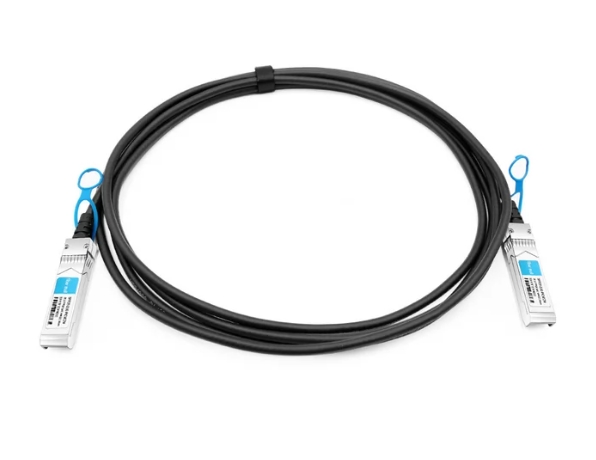
Understanding Direct Attach Copper Twinax Cables
Direct Attach Copper (DAC) Twinax cables are a type of high-speed interconnect designed for short-distance data transmission. These wires have twin copper conductors and are known for their strong performance and low connection loss, making them perfect for 25G applications in data centers. The cables usually have SFP28 connectors on both ends so that they can easily integrate into any compatible network equipment without any difficulties at all. Since DAC twinax cables are passive devices, there is no need for an external power supply, thus simplifying the installation process greatly and cutting down on operation costs, too. Moreover, being small allows these cables to be used more effectively within racks where space is limited while still ensuring proper air flow management and accessibility throughout the entire system setup itself.
Key Specifications of 25G SFP28 DAC Cables
SFP28 DAC cables have been designed for 25G data rates per channel over five 5-meter distances, which can sometimes be prolonged up to 10m. It has a maximum insertion loss of 1.2 dB/m, ensuring high signal fidelity and minimum degradation during transmission. These cables comply with IEEE 802.3bj standards and are thus suitable for Ethernet applications. The cable gauge typically varies from 24 AWG to 30 AWG, where smaller numbers represent bigger sizes that enable better performance. Moreover, they are compatible backward with SFP interfaces as well as SFP+ interfaces, hence allowing them to be used flexibly within combined environments. Being passive means these cables consume less power, which is consistent with modern data centers’ operational requirements, making them more energy efficient in such scenarios.
Advantages of Using 25G SFP28 Passive Direct Attach Copper
Using 25G SFP28 passive direct attach copper (DAC) cables benefits data center operations in several ways. First, these cables save a lot of money compared to optical transceivers since they don’t need extra active components or external power, thus lowering the overall infrastructure costs and making them ideal for high-speed interconnects on a budgetary basis. Secondly, DAC cables have low latency, which is essential for real-time data transmission applications as they allow faster transfers with minimum delay.
Another advantage is the simplicity of installation, where typically most DAC cables are plug-and-play and hence can be quickly deployed within network environments. Also, due to their small size and weight, they help in good cable management that enhances better airflow through racks, thereby reducing the risk of overheating. Finally, the durability feature comes into play because passive-designed DACs are more robust, which ensures sustained performance even under crowded networking conditions over time. All these merits make 25G SFP28 passive DAC cables the best choice for affordable and influential networks in modern data centers.
How Does a 25G SFP28 DAC Cable Work?
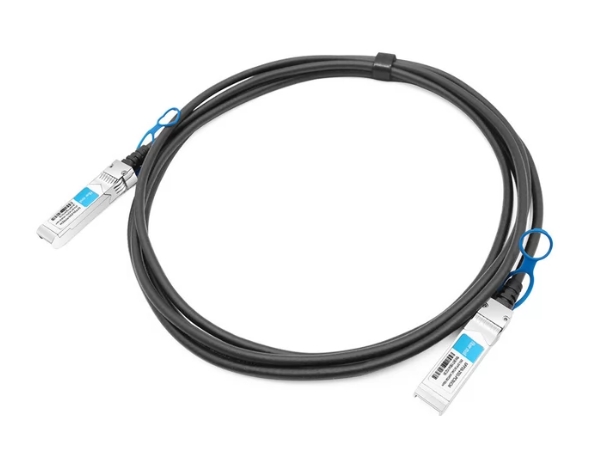
Core Components of Twinax Copper Cable
Often used in high-speed data transmission applications, twinax copper cables have several essential elements that contribute to their performance and reliability.
- Conductors: Twinax cables are typically designed with two inner conductors that carry differential signals. This helps eliminate electromagnetic interference (EMI) and thus makes the transmission more stable.
- Insulation: Insulation material is used around conductors to separate individual wires while maintaining electrical integrity. It should possess the high dielectric strength necessary for supporting the cable’s high-speed data characteristics.
- Shielding: Foil or braided copper shielding is incorporated into the cable itself. The additional layer protects against outside interference by minimizing crosstalk and noise, which can distort or disrupt signals passing through them, thereby preserving signal quality.
- Outer Jacket: At last, an outer jacket is wrapped around the entire assembly so as to protect internal components from physical damages caused by various environmental factors such as moisture ingress or sunlight exposure, among others. The material used for this purpose should be flexible yet rugged enough to ensure durability under different installation conditions like tight bends, etc.
These constituent parts interact holistically to enable twinax copper cables to support high bandwidths effectively and provide low latency transmissions needed by modern network applications.
The Role of SFP28 Transceivers
Facilitating the connection between devices over a 25 Gigabit Ethernet interface in high-speed networking environments is the most crucial use of SFP28 transceivers. These modules are compact and hot-pluggable, which means they can work with both copper and optical fiber cables depending on what is best suited for the network. Here are some main functions served by SFP28 transceivers:
- Transmission of Data: They allow data to be sent at speeds up to 25 Gbps, thus supporting applications like high-frequency trading, data center interconnects, or cloud computing, where low latency is critical.
- Supporting protocols: SFP28 transceivers support many protocols, such as 25G Ethernet and 32G Fibre Channel, making them compatible with different types of network infrastructure while avoiding proprietary solutions.
- Variability in Form Factors: These modules have various form factors, including short-range (SR), long-range (LR), or extended-range (ER), thus ensuring that they work effectively across multiple covering distances and environments.
In conclusion, SFP28 transceivers are essential components of modern networks. Without them, systems wouldn’t be able to provide the required level of performance in terms of bandwidth efficiency and data transmission speed.
Installation Process for 25G Direct Attach Cables
Installing 25G direct attach cables (DAC) is simple; however, it must follow specific steps for better reliability and performance. Below is a summarized guide from the best sources:
- Preparation: Before beginning the installation process, it is essential to switch off the power supply on network devices so as not to cause any damage while making connections. Gather all required tools, such as cable management accessories and markers, for easy identification.
- Selecting Cables: Ensure you choose DACs that match distance requirements and work with the SFP28 transceivers being used. The cable length should be right for your application, as it ranges from 0.5 meters to 7 meters.
- Connecting Cables: Carefully line up the DAC connector with the network device’s SFP28 port; once well inserted, there should be a clicking sound that shows the connection is tight enough. Do not apply too much pressure during this step, as it may damage ports.
- Cable Organization: Arrange wires neatly using cable management products like Velcro straps or trays so they don’t get tangled together. This also helps during future maintenance activities or troubleshooting when necessary.
- Power Up & Test: After completing all connections, turn on the power for network devices. Carry out diagnostic tests to check whether DACs are working correctly, and, if possible, monitor link performance using tools that can verify the expected speed at the interface level.
These steps will help anyone install and manage 25G Direct Attach Cables effectively, thus creating a stable and efficient network environment.
What Are the Benefits of 25G SFP28 DAC Cables?
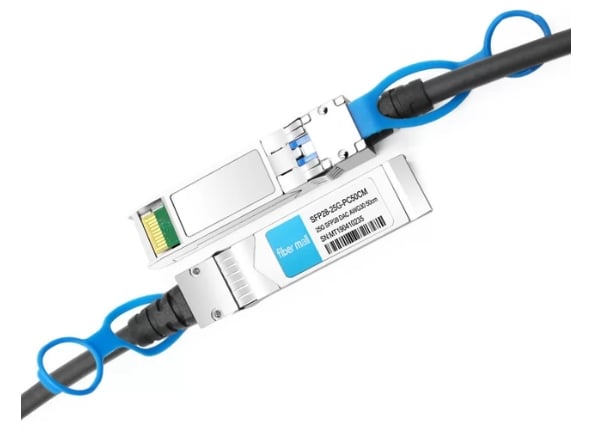
Cost-Effectiveness and Power Consumption
In comparison to active optical cables or traditional fiber optics, 25G SFP28 Direct Attach Cables (DACs) are commonly known for being the most inexpensive. This is because they usually have cheap raw materials and manufacturing methods that can save infrastructure costs. Another merit of DACs is reduced power usage, which occurs when no extra energy is needed to transmit signals through them; hence, this feature becomes more advantageous in cases with huge power requirements per deployment. The passiveness of these devices makes them consume less electricity, thus saving on operation expenses with time. In general, the 25G SFP28 DACS helps companies maximize network performance while dealing with budget and ecological issues simultaneously.
Performance: Bandwidth and Data Transfer Rates
They made 25G SFP28 Direct Attach Cables (DACs) with high bandwidth and great data transfer rates. With 25 Gbps per channel as their native capacity, these cables enable different network devices to communicate with each other smoothly, which makes them perfect for cloud computing, data center interconnections, and high-frequency trading where large amounts of information are involved. Unlike other types of cables, DACs have very low latency, meaning they don’t cause much delay while transmitting data packets, thus increasing network reactivity. Moreover, when used within a 25G network environment, DACs can effectively transmit signals up to 5 meters away, so they work well for short-range connections commonly seen in equipment racks. 25G SFP28 DACS are considered best for modernizing network infrastructures because they combine efficiency at small distances with high performance and minimum delays when sending more significant volumes of information across various points.
Reliability and Durability in Data Centers
The 25G SFP28 Direct Attach Cables (DACs) were created to be solid and long-lasting, essential in data centers. They can always work without getting damaged because DACs are built well. The passive design means no external power sources are needed, so fewer things could break, making the whole system more reliable. In addition, they also can maintain performance levels for extended periods, which is very necessary when running a data center as it helps maximize uptime. DAC resilience against temperature changes and electromagnetic interference has been increased by quality assurance measures such as testing them against industry standards under strict conditions. All these qualities combined make 25G SFP28 DACs an excellent choice for ensuring data integrity and operational continuity in high-demand data center environments where this might not always be guaranteed.
Are 25G SFP28 DAC Cables Compatible with Existing Infrastructure?
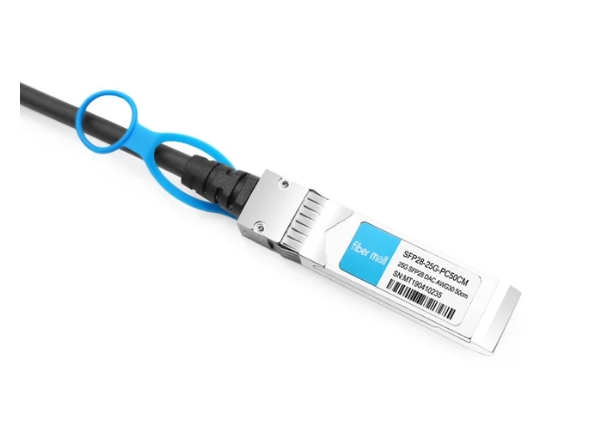
Compatibility with Different Network Standards
These 25G SFP28 Direct Attach Cables (DACs) can fit many network standards. It can also work well with 25G Ethernet (IEEE 802.3) standards to support fast data applications. Moreover, it can be backward-compatible with 10G SFP+ interfaces so that it can be flexibly deployed in the existing infrastructures as well. This ensures that organizations can utilize their current network investments while upgrading to higher bandwidth solutions. DACs are helpful for various equipment, such as switches, routers, and servers produced by different manufacturers; therefore, they help simplify the integration process within various networking environments. The versatility of these cables makes them more helpful in meeting current or future networking needs, too.
Integrating with 10GTEK and Other Brands
The standard design and interoperability of 25G SFP28 DAC cables enable them to be integrated with 10GTEK or other brands. An organization that produces some the highest quality networking products is 10GTEK. These DAC options are designed to conform with industry specifications, making sure they are compatible with many network devices. This means that users can connect 25G SFP28 DACs directly into switches and routers made by 10GTEK without having any issues related to compatibility, which could have been expected were it not for these being IEEE compliant, while other vendors such as Cisco or Arista also manufacture devices capable of supporting this type of technology fully well. Such an ability allows for easy cross-brand purchasing while simplifying network design flexibility. Organizations can choose equipment from various suppliers depending on their needs and still achieve the best performance levels throughout their networks.
MSA Compliance and Interoperability
To ensure the ability of 25G SFP28 DAC cables to work with different systems and suppliers, they must comply with a Multi-Source Agreement (MSA). MSA defines how these wires should be designed and performed, allowing companies to manufacture compatible items. This makes it possible for one to use a DAC in any networking environment and choose from many options during implementation while still achieving a plug-and-play experience. Besides, such interoperability is even more guaranteed if all manufacturers abide by universally recognized rules like those outlined by IEEE, among others, which will make various vendors’ hardware function together seamlessly, thus reducing management overhead costs tied to running multiple networks from different vendors. Compliance also supports efficiency in operations, besides reflecting upon the need to standardize networking technologies amidst ever-changing trends within this space.
What are the common issues with 25G SFP28 DAC cables, and how can they be Resolved?

Troubleshooting Connectivity Problems
If a 25G SFP28 DAC cable has connectivity issues, some common problems can be fixed in a logical order. One should start by looking for visible damages on the cables since any visible wear or deformation will lead to signal degradation. They must also check if their DACs are securely plugged into the correct SFP28 ports because some intermittent connections may be caused by loose connections. Also, they need to verify that the devices involved have been powered well and configured to support 25G operations.
Another important thing is ensuring cable length; typically, these types of cables have certain limitations based on the quality of signal transfer and electromagnetic interference (EMI). If this does not work out, then try doing a loopback test so as to isolate whether it’s the cable itself that has a problem or the device at the other end of the connection. Finally, updating firmware and drivers regularly on connected hardware can help resolve compatibility bugs while improving network performance in general, which is considered one of many good practices for network maintenance.
Dealing with Incompatibility Issues
Problems between 25G SFP28 DAC cables are not compatible because there are different producers whose specifications and technologies don’t work together in most cases. A good starting point would be ensuring that both ends of a cable meet the required standards, especially those set by the Multi-Source Agreement (MSA) for SFP28 transceivers. Sometimes, checking compatibility lists provided by manufacturers or referring to their technical documentation can tell whether components will work fine with each other or not.
Moreover, updating firmware and software versions on networking devices where these cables are being used is important. Manufacturers often release updates that come with better performance levels and improved compatibility features for new hardware introduced into marketplaces faster than ever before. If all else fails, use the brand of cables recommended by the vendor, as third-party options could have specification misalignments leading to lower performances. Reading through the system’s technical requirements more carefully while also reviewing manuals’ interoperability sections should help resolve most issues caused by incompatible systems.
Ensuring Optimal Performance of Your DAC Cable Assemblies
Several things must be considered to ensure that Direct-Attach Copper cable assemblies perform optimally. One of the most important is good cable management, which prevents physical stress or kinks that may cause signal degradation. Keeping within appropriate lengths without too much slack can reduce losses and maintain the quality of fast data transfer integrity.
In addition to this, the environment also greatly affects performance. It should be noted that DAC cables need to be stored at moderate temperatures since their characteristics may be interfered with by excess heat. Hence, it is recommended that you put them in well-ventilated places so they don’t overheat.
Another preventive measure involves subjecting these assemblies to occasional tests through diagnostic equipment; such practice could reveal any possible problem in advance. For instance, signal strength might be examined using Optical Time Domain Reflectometers (OTDR) for passive optical networks or Ethernet testers, which assess signal quality and integrity. Finally, following the manufacturer’s instructions while installing these components will improve reliability and durability, thus meeting the required speeds for networking applications.
Reference Sources
Frequently Asked Questions (FAQs)
Q: What is a 25G SFP28 Twinax Direct Attach Copper Cable?
A: A passive direct attach copper twinax cable for 25G Ethernet connectivity between racks and across adjacent racks; this type of cable is called a 25G SFP28 Twinax Direct Attach Copper Cable. It uses SFP28 connectors and is intended for short-distance connections (0.5 to 5 meters usually).
Q: What distinguishes a passive direct attach copper cable from an active optical cable?
A: The lack of active components or power in operation makes passive direct-attach copper cables much more straightforward and cheaper for short-range connections like the 25G SFP28 DAC Twinax. On the other hand, active optical cables utilize transceivers and optical fiber to achieve longer-range communication, thus being suitable for extended reach within data centers.
Q: Why should I use a 25G SFP28 to SFP28 passive direct attach copper cable?
A: Lower cost than fiber optic solutions, low power consumption, reduced latency, and ease of installation are some of the benefits associated with using them. These cables comply with SFF-8402 and IEEE standards, which make them suitable for reliable application in 25G Ethernet environments.
Q: Can I use 25G SFP28 DAC Twinax cables with my current network equipment?
A: Yes, they are compliant with IEEE and SFF-8402 standards, thereby ensuring compatibility among various brands or models of devices designed specifically for connection over 25 gigabit per second Ethernet links, such as compatible passive direct-attach copper cables that support this speed together with different switches.
Q: Why is the 30AWG gauge commonly used in 25G SFP28 DAC Twinax cables, and what does it do?
A: People opt for this gauge when working on these types of cords mainly because it provides flexibility and signal integrity, combined with space-saving features that make it applicable within high-density data center environments.
Q: How do customers rate 25G SFP28 DAC Twinax cables?
A: According to customer reviews, the 25G SFP28 to SFP28 passive direct attach copper cable performs very well in terms of performance, reliability, and cost-effectiveness. They also said that these cables work with a lot of network equipment and can be installed easily.
Q: Can 25G SFP28 passive DAC cables support data and storage networking?
A: Yes, 25G SFP28 passive DAC cables are designed for use in data and storage networking environments. They provide high-speed, low-latency connections for enterprise data centers, cloud computing, and high-performance computing, among other applications.
Q: What is the typical range of 25G SFP28 to SFP28 passive DAC cables?
A: These cables are generally between 0.5 meters and 5 meters long. This makes them suitable for short-distance connections within racks or across adjacent racks within a single data center.
Q: How do passive direct attach copper cables relate to optical fiber cables?
A: Passive direct-attach copper cables such as the 25G SFP28 DAC Twinax are more economical than optical fiber for short-distance connection installation because they cost less and take less time to install; however, where distances are longer, optical fibers are preferable because they have higher bandwidths, which leads to lower signal losses over long distances.
Q: What standards should I consider when buying a 25G SFP28 DAC Twinax cable?
A: Check whether it meets industry requirements as stipulated by such bodies as IEEE P802.3by Ethernet standard, or even better, make sure it complies with all applicable standards, including but not limited to SFF-8402, so that you get what you need in terms of performance and compatibility.
Related Products:
-
 SFP28-25G-PC50CM 50cm (1.6ft) 25G SFP28 to SFP28 Passive Direct Attach Copper Cable
$18.00
SFP28-25G-PC50CM 50cm (1.6ft) 25G SFP28 to SFP28 Passive Direct Attach Copper Cable
$18.00
-
 SFP28-25G-PC1.5M 1.5m (5ft) 25G SFP28 to SFP28 Passive Direct Attach Copper Cable
$20.00
SFP28-25G-PC1.5M 1.5m (5ft) 25G SFP28 to SFP28 Passive Direct Attach Copper Cable
$20.00
-
 SFP28-25G-PC2M 2m (7ft) 25G SFP28 to SFP28 Passive Direct Attach Copper Cable
$23.00
SFP28-25G-PC2M 2m (7ft) 25G SFP28 to SFP28 Passive Direct Attach Copper Cable
$23.00
-
 SFP28-25G-PC3M 3m (10ft) 25G SFP28 to SFP28 Passive Direct Attach Copper Cable
$30.00
SFP28-25G-PC3M 3m (10ft) 25G SFP28 to SFP28 Passive Direct Attach Copper Cable
$30.00

